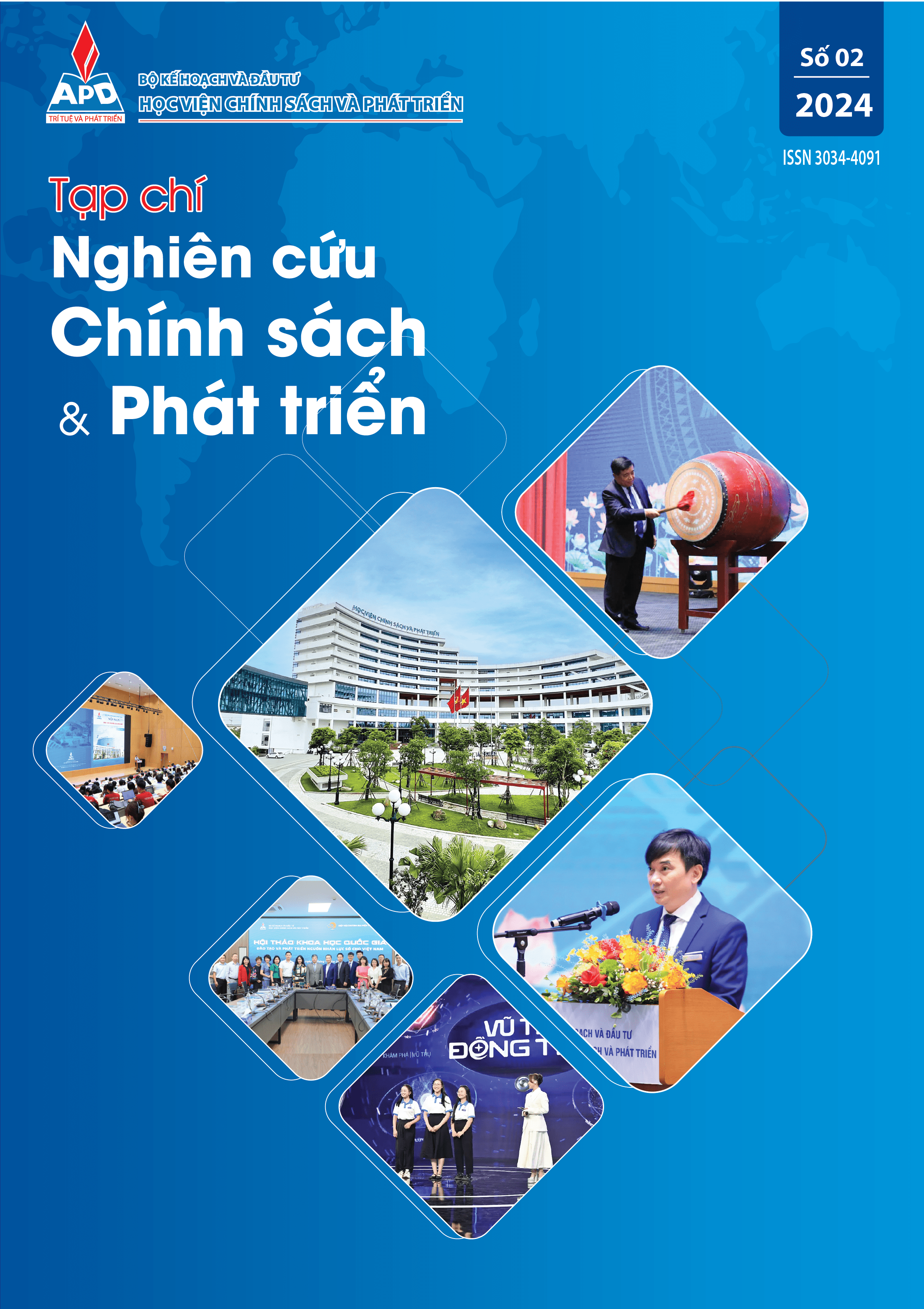Đổi mới sáng tạo và tăng trưởng kinh tế Kinh nghiệm của Trung Quốc và bài học cho Việt Nam
Tải xuống
Đã Xuất bản
Cách trích dẫn
Số
Chuyên mục
Từ khóa:
chi tiêu cho R&D, ĐMST, nghiên cứu và phát triển, tăng trưởng kinh tếTóm tắt
Việc tăng trưởng kinh tế của mỗi quốc gia được thúc đẩy bởi thay đổi công nghệ, nghiên cứu và phát triển (R&D), trong đó chi tiêu cho R&D là một chỉ số quan trọng phản ánh sự đổi mới sáng tạo của các quốc gia. Năm 2023, Việt Nam được xếp hạng thứ 46 trong tổng số 132 quốc gia về hoạt động đổi mới sáng tạo (ĐMST) nhưng Việt Nam vẫn đang đối mặt với rất nhiều khó khăn và thách thức, chưa tương xứng với tiềm năng trí tuệ và năng lực sáng tạo của con người Việt Nam. Nghiên cứu này nhằm mục đích đánh giá tác động của ĐMST đến tăng trưởng kinh tế của Trung Quốc, một quốc gia có nhiều điểm tương đồng với Việt Nam về nhân chủng học cũng như văn hóa. Qua đó, chúng tôi sẽ đưa ra một số bài học kinh nghiệm cho Việt Nam nhằm hướng đến một quốc gia phát triển vào năm 2045. Dữ liệu nghiên cứu được thu thập từ nguồn tin cậy của World Bank, OECD and ILO trong giai đoạn từ năm 1991 đến 2021.
Tài liệu tham khảo
1. Aghion, P. and Howitt, P. A. (1992), Model of Growth Through Creative Destruction, Econometrica, 60(2), 323-351.
2. Aghion, P., Bloom, N., Blundell, R., Griffith, R., Howitt, P. (2005). Competion and innovation: an inverted U relationship. Quarterly Journal of Economics, 120 (2), 701-728.
3. Aghion, P., Harmgart, H., Weisshaar, N. (2009). The causal impact of education on growth: evidence from US. Mimeo, Harvard University.
4. Bayarcelik, E.B. and Tasel, F. (2012), Research and Development: Source of Economic Growth. Social and Behavioral Sciences: 8th International Strategic Management Conference, Barcelona, Spain, June 21-23, 104-111.
5. Đàm, T. T. and Đàm, T. H. (2024). Innovation and economic growth - research from experimental models in developing countries and lessons learned for Vietnam. Proceeding of International conference Sustainable economic development: Opportunities and Challenges. Haiphong City, 442-454.
6. ILO (2024). Data catalogue. Retrieved from < https://ilostat.ilo.org/topics/youth/>.
7. Inglesi L., Chang, T. and Gupta, R. (2015), Causality Between Research Output and Economic Growth in BRICS. Quality & Quantity, 49(1), 167–176.
8. Nadiri, I. (1993). Innovations and Technological Spillovers. Working Paper 423- National Bureau of Economic Research. Cambridge, MA.
9. Ntuli, H., Inglesi, L., Chang, T., and Pouris, A. (2015), A. Does Research Output Cause Economic Growth or Vice Versa? Evidence from 34 OECD Countries, Journal of the Association for Information Science and Technology, 66(8), 1709-1716. https://doi.org/10.1002/asi.23285.
10. OECD (2020). Main Science and Technology Indicators. Retrieved from <https://dataexplorer.oecd.org/>.
11. OECD (2024), Gross domestic spending on R&D (indicator). https://doi.org/10.1787/d8b068b4-en
12. Pala, A. (2019), Innovation and Economic Growth in Developing Countries: Empirical Implication of Swamy’s Random Coefficient Model, 3rd World Conference on Technology, Innovation and Entrepreneurship (WOCTINE). https://doi.org/10.1016/j.procs.2019.09.252.
13. Pece, A. M., Simona, O. E., Salisteanu, F. (2015), Innovation and economic growth: An empirical analysis for CEE countries, 4th World Conference on Business, Economics and Management, WCBEM. Procedia Economics and Finance 26 (2015), 461 – 467.
14. Pessoa, A. (2007). Innovation and Economic Growth: What is the actual importance of R&D?. University of Porto, FEP Working Papers, No. 254, 1- 17.
15. Petrariu, I. R, Bumbac, R., Ciobanu, R. (2013). Innovation: a path to competitiveness and economic growth. The case of CEE countries, Theoretical and Applied Economics, 5(582), 15-26.
16. Romer, P.M. (1986). Increasing Returns and Long Run Growth, Journal of Political Economy, Vol. 98, 71-102
17. Romer, P.M. (1990). Endogenous Technological Change. Journal of Political Economy. 98(2), 337-367. 18. Schumpeter, J., A. (1939). Business Cycles: A Theoretical, Historical and Statistical Analysis of the Capitalist Process. Vol.1, McGraw-Hill, New York.
19. Solow, R. (1956). A Contribution to the Theory of Economic Growth, The Quarterly Journal of Economics. 70(1), 65-94.
20. Ulku, H. (2004). R&D, Innovation, and Economic Growth: An Empirical Analysis. International Monetary Fund Working Papers. WP/04/185, 2-35.
21. Westmore, B. (2013). R&D, Patenting and Growth: The Role of Public Policy. OECD Economics Department Working Papers. No. 1047, OECD Publishing, 2-48.
22. Westerlund, J. and D. Edgerton (2008). A Simple Test for Cointegration in Dependent Panels with Structural Breaks, Oxford Bulletin of Economics and Statistics, 70, 665-703.
23. WIPO (2023). Global Innovation Index 2023. Switzerland: ISBN: 978-92-805-3321-7. Retrieved from < https://www.wipo.int/global_innovation_index/en/202 3/>.
24. World Bank (2024). World Bank Open Data. Retrieved from < https://data.worldbank.org> Wong, K.P., Ho, Y.P., Autio, E. (2005). Entrepreneurship, Innovation and Economic Growth: Evidence from GEM data, Small Business Economics, 24(3), 335-350.
25. Xinhua (2023). China's spending on R&D hits 3 trln yuan in 2022. Retrieved from <https://english.www.gov.cn/archive/statistics/202301 /23/content_WS63ce3db8c6d0a757729e5fe5.html>







